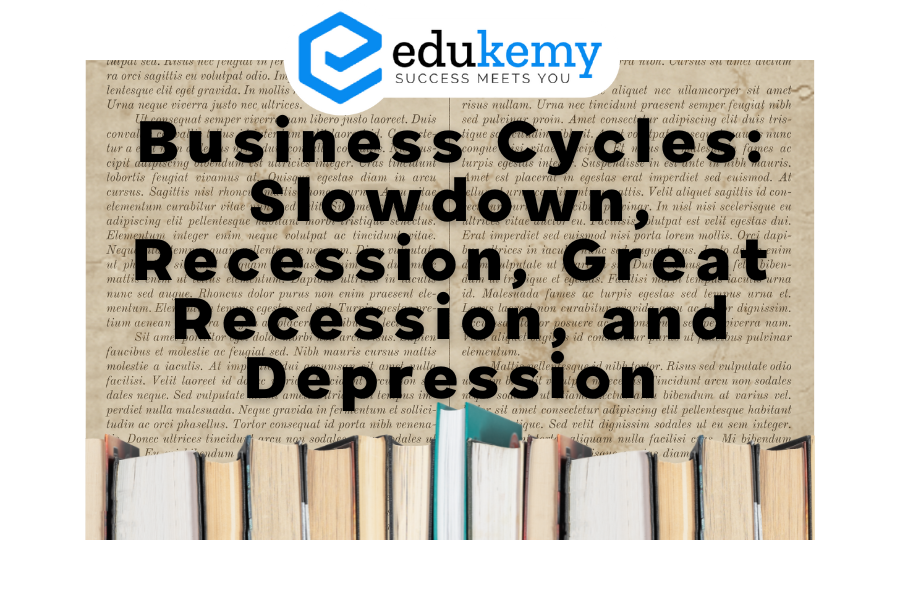
Business cycles are fluctuations in economic activity characterized by periods of expansion, peak, contraction, and trough. These cycles represent the natural ebb and flow of economic growth, driven by various factors such as consumer spending, investment, government policies, and external shocks.
Economic growth is inherently cyclical, characterized by alternating periods of expansion and stagnation or decline. This cyclical nature is a fundamental aspect of any nation’s economy, where periods of boom are inevitably followed by periods of bust. Various factors, both inherent and external to the growth process, can influence these cycles.
Contents
- 1 Business Cycle Phases:
- 2 FAQs
- 2.1 Q1: What causes a slowdown in the business cycle?
- 2.2 Q2: How is a recession defined in the context of business cycles?
- 2.3 Q3: What distinguishes the Great Recession from other economic downturns?
- 2.4 Q4: How does a depression differ from a recession?
- 2.5 Q5: What are some common policy responses to mitigate the effects of a recession or depression?
- 3 In case you still have your doubts, contact us on 9811333901.
Business Cycle Phases:
- Boom: During a boom, economies experience increased production due to economies of scale. This leads to cheaper supplies, but sales may take time to catch up, resulting in a period of rapid growth.
- Slowdown: A slowdown occurs when the pace of economic growth starts to decelerate. This can be triggered by factors like rising commodity prices leading to inflation, which reduces demand.
- Recession/Contraction/Degrowth: A recession is characterized by a sustained period of negative economic growth. It occurs when an economy produces less than in previous periods. This phase is marked by a decline in various macroeconomic indicators.
Causes of Recession: Recessions can be caused by a range of events, including financial crises, external trade shocks (such as oil price spikes or supply disruptions), and, rarely, global events like pandemics (as seen with COVID-19 in 2020).
Government Response to Recession: Governments typically respond to recessions with expansionary macroeconomic policies. These measures may include increasing the money supply, boosting government spending, and reducing taxation to stimulate economic activity.
Double-Dip Recession: If a recession relapses after corrective measures are taken, it’s referred to as a double-dip recession. This scenario can lead to further job losses and deeper deflation.
Great Recession: A great recession is a severe and prolonged economic contraction. It is characterized by significant job losses, substantial deflation, and a marked decline in various economic indicators. The global financial crisis of 2008 is a prominent example of a great recession.
Depression: If a great recession persists and deepens, resulting in a contraction of GDP by approximately 10% or more, it is classified as a depression. This is an extreme economic downturn that can have profound and long-lasting effects on a nation’s economy.
Conclusion: Understanding the phases of the business cycle, from boom to depression, is crucial for policymakers and economists alike. Recognizing the signs and causes of economic slowdowns and recessions enables governments to implement appropriate measures to stabilize and revitalize their economies.
FAQs
Q1: What causes a slowdown in the business cycle?
A1: A slowdown in the business cycle can be triggered by various factors such as a decrease in consumer spending, tightening monetary policies, declining business investment, or external shocks like geopolitical tensions or natural disasters.
Q2: How is a recession defined in the context of business cycles?
A2: A recession is commonly defined as a significant decline in economic activity across the economy, typically measured by a decrease in GDP for two consecutive quarters. It is characterized by reduced consumer spending, decreased investment, rising unemployment, and overall economic contraction.
Q3: What distinguishes the Great Recession from other economic downturns?
A3: The Great Recession refers to the severe global economic downturn that began in late 2007 and lasted until 2009. It was characterized by a financial crisis, housing market collapse, widespread banking failures, and a sharp decline in economic output. The magnitude and global reach of its impact set it apart from typical recessions.
Q4: How does a depression differ from a recession?
A4: A depression is an extreme and prolonged economic downturn characterized by a severe contraction in economic activity, widespread unemployment, deflation, and significant disruptions in financial markets. Depressions are typically more severe and longer-lasting than recessions, often lasting several years.
Q5: What are some common policy responses to mitigate the effects of a recession or depression?
A5: Policy responses to economic downturns often include fiscal stimulus measures such as increased government spending or tax cuts to stimulate demand, monetary policy actions like lowering interest rates or implementing quantitative easing to encourage borrowing and investment, and regulatory reforms to stabilize financial markets and prevent future crises.
In case you still have your doubts, contact us on 9811333901.
For UPSC Prelims Resources, Click here
For Daily Updates and Study Material:
Join our Telegram Channel – Edukemy for IAS
- 1. Learn through Videos – here
- 2. Be Exam Ready by Practicing Daily MCQs – here
- 3. Daily Newsletter – Get all your Current Affairs Covered – here
- 4. Mains Answer Writing Practice – here

